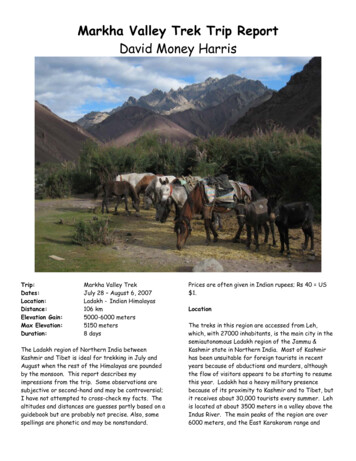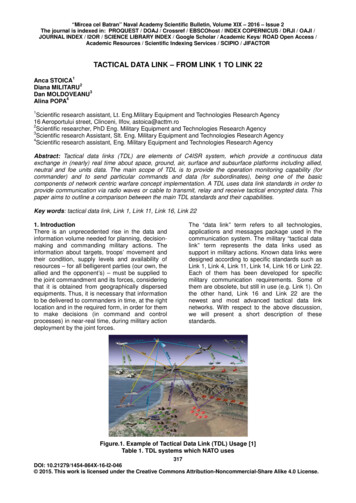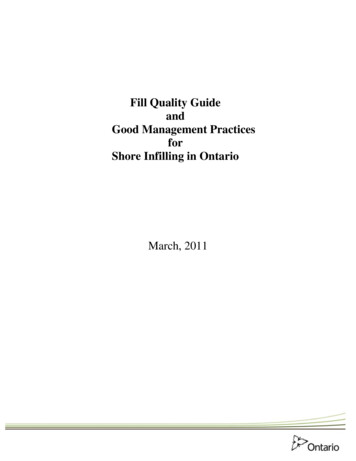
Transcription
Trekking the Shore
INTERDISCIPLINARY CONTRIBUTIONS TO ARCHAEOLOGYSeries Editor: Jelmer Eerkens, University of California Berkeley, Berkeley, CA, USAFounding Editor: Roy S. Dickens, Jr., Late of University of North Carolina,Chapel Hill, NC, USAFor further volumes:http://www.springer.com/series/6090
Nuno F. Bicho Jonathan A. HawsLoren G. Davis EditorsTrekking the ShoreChanging Coastlines and the Antiquityof Coastal Settlement
EditorsNuno F. BichoFCHS, Campus de GambelasUniversidade do AlgarveFaroPortugalnbicho@ualg.ptLoren G. DavisDepartment of AnthropologyOregon State University238 Waldo Hall, Corvallis, OR 97331USAloren.davis@oregonstate.eduJonathan A. HawsDepartment of AnthropologyUniversity of LouisvilleLouisville, KY 40292USAjonathan.haws@louisville.eduISBN 978-1-4419-8218-6e-ISBN 978-1-4419-8219-3DOI 10.1007/978-1-4419-8219-3Springer New York Dordrecht Heidelberg LondonLibrary of Congress Control Number: 2011926798 Springer Science Business Media, LLC 2011All rights reserved. This work may not be translated or copied in whole or in part without the writtenpermission of the publisher (Springer Science Business Media, LLC, 233 Spring Street, New York,NY 10013, USA), except for brief excerpts in connection with reviews or scholarly analysis.Use in connection with any form of information storage and retrieval, electronic adaptation, computersoftware, or by similar or dissimilar methodology now known or hereafter developed is forbidden.The use in this publication of trade names, trademarks, service marks, and similar terms, even if theyare not identified as such, is not to be taken as an expression of opinion as to whether or not they aresubject to proprietary rights.Printed on acid-free paperSpringer is part of Springer Science Business Media (www.springer.com)
ContentsPart I1North America and EurasiaThe North American Paleocoastal Concept Reconsidered.Loren G. Davis2 Prehistoric Archaeology Underwater: A Nascent SubdisciplineCritical to Understanding Early Coastal Occupationsand Migration Routes.Amy E. Gusick and Michael K. Faught3 Early Environments and Archaeology of CoastalBritish Columbia.Quentin Mackie, Daryl Fedje, Duncan McLaren,Nicole Smith, and Iain McKechnie327514 Blessing the Salmon: Archaeological Evidencesof the Transition to Intensive Fishing in the FinalPaleolithic, Maritime Region, Russian Far East. 105Andrei V. Tabarev5 Early Technological Organization Along the EasternPacific Rim of the New World: A Co-Continental View. 117Samuel C. Willis and Matthew R. Des Lauriers6 Technology, Mobility, and Adaptation Among EarlyForagers of the Southern Northwest Coast: The Viewfrom Indian Sands, Southern Oregon Coast, USA. 137Loren G. Davis and Samuel C. Willis7Of Clams and Clovis: Isla Cedros, Baja California, Mexico. 161Matthew R. Des Lauriersv
viContents8Changes in Molluscan Exploitation Patterns During the LatePleistocene and Early Holocene in Eastern Cantabria(Northern Spain). 179F. Igor Gutiérrez-Zugasti9Paleolithic Landscapes and Seascapesof the West Coast of Portugal. 203Jonathan A. Haws, Caroline L. Funk, Michael M. Benedetti,Nuno F. Bicho, J. Michael Daniels, Thomas A. Minckley,Rhawn F. Denniston, Marjeta Jeraj, Juan F. Gibaja,Bryan S. Hockett, and Steven L. Forman10Small Game and Marine Resource Exploitationby Neanderthals: The Evidence from Gibraltar. 247Kimberly Brown, Darren A. Fa, Geraldine Finlayson,and Clive Finlayson11Prying New Meaning from Limpet Harvestingat Vale Boi During the Upper Paleolithic. 273Tiina Manne and Nuno F. Bicho12Surf and Turf: The Use of Marine and TerrestrialResources in the Early Neolithic of CoastalSouthern Portugal. 291Rebecca M. Dean and António Faustino CarvalhoPart II South America, Africa, and Oceania13Pinniped Zooarchaeological Studies in Southern Patagonia:Current Issues and Future Research Agenda. 305A. Sebastián Muñoz14The Use of the Space in the Pampean Atlantic Coastand the Adjacent Plains (Argentina, South America):A Comparative View. 333Mariano Bonomo15Coastal Resources and the Early HoloceneLas Vegas Adaptation of Ecuador. 355Karen E. Stothert16Initial Investigations into the Exploitation of CoastalResources in North Africa During the Late Pleistoceneat Grotte Des Contrebandiers, Morocco. 383Teresa E. Steele and Esteban Álvarez-Fernández
Contentsvii17Shellfishing and the Interpretation of Shellfish Sizesin the Middle and Later Stone Ages of South Africa. 405Judith Sealy and Mariagrazia Galimberti18Coastal South Africa and the Coevolution of the ModernHuman Lineage and the Coastal Adaptation. 421Curtis W. Marean19Coastal Foragers on Southern Shores: Marine ResourceUse in Northeast Australia since the Late Pleistocene. 441Sean Ulm20The Role of Marine Resources in the Diet of Pre-ColonialAboriginal People and Land Use Patterns AroundPort Jackson, Sydney, New South Wales, Australia. 463Val AttenbrowIndex. 493
wwwwwwwwwwwwwwwwww
ContributorsEsteban Álvarez-FernándezDpto. de Prehistoria, Historia Antigua y Arqueología,Universidad de Salamanca, Salamanca, Spainestebanalfer@hotmail.comVal AttenbrowAustralian Museum, Sydney, NSW, Australiaval.attenbrow@austmus.gov.auMichael M. BenedettiDepartment of Geography and Geology, University of NorthCarolina-Wilmington, Wilmington, NC, USAbenedettim@uncw.eduNuno F. BichoFCHS, Campus de Gambelas, Universidade do Algarve,Faro, Portugalnbicho@ualg.ptMariano BonomoCONICET- Departamento Científico de Arqueología, Facultad de CienciasNaturales y Museo (UNLP), Pase del bosque s/nº, (1900) La Plata, Argentinambonomo@fcnym.unlp.edu.arKimberly BrownThe Gibraltar Museum, 18-20 Bomb House Lane, Gibraltarkbrown@gibraltar.giAntónio F. CarvalhoDepartamento de História, Arqueologia e Património,Universidade do Algarve, Faro, Portugalafcarva@ualg.ptJ. Michael DanielsDepartment of Geography, University of Denver,ix
xContributorsDenver, CO, USAj.michael.daniels@du.eduLoren G. DavisDepartment of Anthropology, Oregon State University,238 Waldo Hall, Corvallis, OR 97331, USAloren.davis@oregonstate.eduRebecca M. DeanDivision of Social Sciences, University of Minnesota-Morris,600 E. 4th Street, Morris, MN 56267, USArdean@umn.eduRhawn F. DennistonDepartment of Geology, Cornell College,Mt. Vernon, IA, USARDenniston@cornellcollege.eduMatthew R. Des LauriersDepartment of Anthropology, Anthropological Research Institute,California State University, Northridge, 18111 Nordhoff Avenue, Northridge,CA 91330, USAmdeslaur@csun.eduDarren A. FaThe Gibraltar Museum, 18-20 Bomb House Lane, Gibraltardarrenfa@gibraltar.giMichael K. FaughtMaritime Archaeology, Panamerican Consultants, Inc.703 Truett Drive, Tallahassee, FL 32303, USAmfaught@comcast.netDaryl FedjeWestern and Northern service Center, Parks Canada, Victoria, BC, Canadadaryl.fedje@pc.gc.caClive FinlaysonThe Gibraltar Museum, 18-20 Bomb House Lane, Gibraltarjcfinlay@gibraltar.giGeraldine FinlaysonThe Gibraltar Museum, 18-20 Bomb House Lane, Gibraltargfjmh@gibraltar.giSteven L. FormanLuminescence Dating Research Laboratory and Department of Earthand Environmental Sciences, University of Illinois,Chicago, IL 60607, USAslf@uic.edu
ContributorsCaroline L. FunkRichfield, MN, USACarolinelfunk@gmail.comMariagrazia GalimbertiDepartment of Archaeology, University of Cape Town,Rondesbosch, South AfricaMariagrazia.Galimberti@uct.ac.zaJuan F. GibajaFCHS, Campus de Gambelas, Universidade do Algarve,Faro, Portugaljfgibaja@teleline.esAmy E. GusickDepartment of Anthropology, University of California,Santa Barbara, CA 93106-3210, USAagusick@umail.ucsb.eduJonathan A. HawsDepartment of Anthropology, University of Louisville,Louisville, KY 40292, USAjonathan.haws@louisville.eduBryan S. HockettUS Bureau of Land Management, Elko, NV, USABryan Hockett@blm.govMarjeta JerajDepartment of Botany, University of Wisconsin-Madison,Madison, WI, USAmjeraj@wisc.eduQuentin MackieDepartment of Anthropology, University of Victoria, Victoria, BC, Canadaqxm@uvic.caTiina ManneDepartment of Anthropology, University of Arizona, Building 30,Tucson, AZ 85731-0030, USAtmanne@email.arizona.eduCurtis W. MareanInstitute of Human Origins, School of HumanEvolution and Social Change, Arizona State University,872402 Tempe, AZ 85287-2402, USAcurtis.marean@asu.eduIain McKechnieDepartment of Anthropology, University of British Columbia,xi
xiiContributorsVancouver, BC, Canadaii@interchange.ubc.caDuncan McLarenDepartment of Anthropology, Cordillera Archaeology and University of Victoria,Victoria, BC, Canadadsmclaren@gmail.comThomas A. MinckleyDepartment of Botany, University of Wyoming, Laramie, WY, USAMinckley@uwyo.eduA. Sebastián MuñozLaboratorio de Zooarqueología y Tafonomía de Zonas Áridas,CONICET-Museo de Antropología, Universidad Nacionalde Córdoba, Av. H. Yrigoyen 174, 5000 Córdoba, Argentinasmunoz@conicet.gov.arJudith SealyDepartment of Archaeology, University of Cape Town,Private Bag X3, Rondesbosch 7701, South AfricaJudith.Sealy@uct.ac.zaNicole SmithWestern and Northern Service Center, Parks Canada, Vancouver, BC, Canadanicole.smith@pc.gc.caTeresa E. SteeleDepartment of Anthropology, University of California,One Shields Avenue, Davis, CA 95616-8522, USAandDepartment of Human Evolution, Max PlanckInstitute for Evolutionary Anthropology, Deutscher Platz 6,04103 Leipzig, Germanytesteele@ucdavis.eduKaren E. StothertDepartment of Anthropology, The University of Texas at San Antonio,San Antonio, Texas 78249, USAkstothert@gmail.comAndrei V. TabarevInstitute of Archaeology and Ethnography, Novosibirsk, Russiatabarev@archaeology.nsc.ruSean UlmDepartment of Anthropology, Archaeology and Sociology,School of Arts and Social Sciences, James Cook University,
ContributorsPO Box 6811, Cairns, QLD 4870, Australiasean.ulm@jcu.edu.auSamuel C. WillisDepartment of Anthropology, Oregon State University,Corvallis, OR, USAwilliss@onid.orst.eduF. Igor Gutiérrez-ZugastiDepartment of Archaeology, BioArch, University of York,Biology S-Block, Wentworth Way, York YO10 5DD,England (UK)igorgutierrez.zug@gmail.comxiii
wwwwwwwwwwwwwwwwww
PrologueNuro F. Bicho, Jonathan A. Haws, and Loren G. DavisIn the last decade, several review articles have laid the groundwork for a new appreciation of prehistoric human coastal adaptations and food resources (e.g.,Bailey and Milner 2002; Bailey et al. 2008; Bailey and Flemming 2008; Erlandson2001; Erlandson and Fitzpatrick 2006). These articles have renewed and updatedmany themes from previous decades and reframed the importance of coasts forhuman societies by casting off many negative assumptions about marine resourcesand environments. Coastal zones are no longer dismissed as marginal areas full of“fall-back” resources of limited economic value. Instead, coastal zones are beingrecast as primary eco-niches for humans from the earliest periods of prehistory tothe present. This perspective shift flows from eight themes driving current interestin coastal archaeology that Erlandson and Fitzpatrick (2006) outlined in their inaugural article for the new Journal of Island and Coastal Archaeology. Much of theimpetus for renewed interest in the antiquity of coastal adaptations derives from anumber of research prerogatives including: the role marine resources played inhuman evolution and dispersal, including migration routes; improved paleoenvironmental studies that have led to new models for human eco-dynamics in coastalzones; application of new technology to explore, map, and characterize submergedlandscapes; the recognition of human impacts on ancient marine environments; andcognitive approaches that use ethnography to inform on past human perceptions ofcoastal landscapes and seascapes. The majority of this new work has been developed in traditional areas of coastal archaeology including Scandinavia, the BritishIsles, and the Pacific Rim.In the spirit of this new focus, we organized two conference symposia on theantiquity of coastal adaptations: one in Lisbon organized by Bicho and Haws for the2006 UISPP congress, the other in Austin organized by Davis for the 2007 Societyfor American Archaeology meeting. While the SAA session focused on latePleistocene colonization of western North America, the UISPP symposium emphasized prehistoric hunter–gatherer coastal adaptations in regions outside traditionalresearch areas. The present volume seeks to expand the spatio-temporal coverageby highlighting the latest research on the antiquity of coastal adaptations.xv
xviN.F. Bicho et al.Coastal Resources in Human EvolutionThe earlier use of marine and estuarine resources during the Paleolithic has been documented over the last several decades (Antunes 1990–91, 2000; Barton 2000;Bicho and Haws 2008; Cleyet-Merle and Madelaine 1995; de Lumley 1969;McBurney 1967; Roche and Texier 1976; Roubet 1969; Souville 1973; Stiner 1994;Waechter 1964). Many of the early reports give simple lists of species without anycritical review of how they got there or their importance in terms of hunter–gathereradaptation. In spite of the recognition that most Pleistocene shores are now submerged and potential sites are unavailable, most archaeologists dismissed orignored this evidence as incidental and concluded that Paleolithic people rarelyutilized marine resources.Within the last two decades, researchers have come to see coastal resources in anew light. Moving beyond energetic considerations that minimize their value,coastal resources are now thought to have played important roles in Paleolithic dietand subsistence (Kuhn and Stiner 2006; Parkington 2001; Pettitt et al. 2003; Stineret al. 2000). In particular, coastal resources may have played a critical role in thedevelopment and expansion of the human brain and retinal quality by providinglong-chain polyunsaturated fatty acids, specifically docosahexaenoic acid (DHA)and arachninoid acid (AA) present in the Omega 3 and Omega 6 series (Broadhurstet al. 1998, 2002; Crawford et al. 1999; Cunnane et al. 1993; Parkington 2001;Uauy and Dangour 2006). These fatty acids, invaluable during pregnancy and earlychildhood, are not produced in the human body (Broadhurst et al. 2002; Jensen2006; Milligan & Bazinet 2008) but occur naturally in aquatic plants and animals.Many of these resources are easily gathered and thus would have been importantelements in Paleolithic subsistence. Some of the easiest resources to collect aremarine shellfish that also provide important sources of essential nutrients for braindevelopment. Among edible species of shellfish, limpets produce the highestamounts of AA and DHA, at least during spawning periods (Brazão et al. 2003;Gardner & Riley 1972). Limpets are also the most common species in many of theearly sites with coastal resources, including Neanderthal sites, such as GrottaBreuil, in Italy (Stiner 1994), Gorham’s and Vanguard caves in Gibraltar (BadenPowell 1964; Barton 2000; Fa 2008; Brown et al. 2011), and Figueira Brava Cavein Portugal (Antunes 1990–91; Callapez 2000). For modern humans there are manyearly examples in South Africa at Klasies River Mouth (Voigt 1982), Pinnacle Point(Marean et al. 2007), Blombos Cave (Henshilwood et al. 2001b), Ysterfontein 1(Avery et al. 2008), and Hoedjies Punt 3 (Parkington 2003) (see also Marean 2011;Sealy and Galimberti 2011) and in North Africa (Steele, this volume). For theUpper Paleolithic, there are numerous sites with shell assemblages dominated bylimpets in Iberia including La Riera (Ortea 1986), Vale Boi (Bicho and Stiner 2006;Manne et al., this volume), Bajondillo (Cortés et al. 2008), and Cueva de Nerja(Morales et al. 1998).If diet choice enabled human brain development and expansion then determining the antiquity of coastal adaptations becomes a critical research prerogative.
ProloguexviiThe current evidence places coastal resource use back to the Middle Pleistoceneduring which a significant leap in the encephalization quotient occurred with theappearance of H. heidelbergensis (Ruff et al. 1997). The presence of H. erectus inIndonesia on the island of Flores 800 ka (Morwood et al. 1998) offers tantalizingevidence for very early sea crossing capability and would suggest good knowledgeof tides necessary to make the trip (see Marean 2011). In Europe, the MiddlePleistocene sites Clacton- on-sea and Boxgrove (Roberts and Parfitt 1999) arelocated in coastal settings but no direct evidence of marine resource use has beendocumented. So far, the oldest evidence for shellfish consumption (de Lumley et al.2004; Villa 1983) comes from Terra Amata (400 ka) and Grotte du Lazaret (250 ka)associated with H. heidelbergensis. Cognitive abilities are widely thought to haveincreased markedly in anatomically modern humans 200 ka (Marean 2011;McBrearty and Brooks 2000). Early modern human shellfish exploitation is evidentnow at Pinnacle Point in South Africa dated to 165 ka (Marean et al. 2007; thisvolume) and the other sites mentioned above. Evidence also exists for coastal settlement and resource utilization by H. neanderthalensis, in Italy (Stiner 1994),Portugal (Bicho 2004; Bicho and Haws 2008; Haws et al. 2011), Spain (Cortés,et al. 2008; Zilhão et al. 2010), and Gibraltar (Finlayson 2008; Brown et al. 2011).In any case, this evidence seems to suggest a frequent use of the coastal settings.In the last two decades, archaeologists have documented human impacts onancient marine and estuarine animal populations. This has emerged as a majorresearch focus in coastal archaeology leading to a proliferation of data from aroundthe world. For the Holocene, worldwide evidence now exists for “fishing down thefood web” in coastal environments (Mannino and Thomas 2002; Rick andErlandson 2008). For the Pleistocene, Klein (1998; Klein et al. 2004) and Stineret al. (2000) have measured size diminution in shellfish between the Middle StoneAge/Middle Paleolithic and Late Stone Age/Upper Paleolithic assemblages inAfrica and the Mediterranean Basin. Steele, Sealy, and Galimberti (this volume)present data to support and question the nature of the evidence.Human Dispersal and MigrationModern human development and diaspora is closely linked to the sea and thecoastal settings. The intensive use of marine resources with specialized technologies seems to be an exclusive trait of modern humans. The presence of bone harpoons at Katanga (Yellen 1998) and bone points in association with fish bones inBlombos Cave (Henshilwood et al. 2001a) provide the earliest evidence for innovation. Rose (2007) and Petraglia and Rose (2009) have championed a Red Sea crossing from the East Africa (Kenya, Somalia, Djibouti, and Eritrea) to the ArabianPeninsula (Oman and Yemen), for the dispersion of modern humans out of Africaand into Asia. The sea was a fundamental factor on the dispersal of modern humansto many archipelagos in the Indian and the Pacific oceans, including New Guinea/Papua ( 35 ka), Australia (40 ka), New Ireland (30 ka), and the Japanese islands
xviiiN.F. Bicho et al.(26 ka) (Allen et al. 1989; Matsu’ura 1996; Roberts et al. 1990; Thorne et al. 1990).These cases are remarkable because they challenge widely held beliefs that humanslacked significant seafaring capabilities prior to the mid-late Holocene.Three decades after Fladmark’s (1979) logical argument, it now appears that thepeopling of the Americas was likely a coastal migration. A coastal migration readily explains the early settlement of Monte Verde at the tip of South America.Coastal settings were highly rich in biomass and offered numerous easy accessibledietary resources. Not surprisingly, the earliest evidence for human settlementalong the West coasts of both continents also includes use of coastal resources(Erlandson et al. 2007, 2008; for a critical review see Davis 2011).Coastal Environments and Human AdaptationFifteen years ago, Price (1995) called for increased understanding of the linkagesbetween coastal productivity and the archaeological record of human adaptations.As Perlman (1980) noted previously, coastal environments are highly variable inproductivity and attractiveness to humans. As a result, human settlement andresource use in these areas will vary in space and time as productivity changes.Two of the richest types of coastal environments are associated with estuariesand upwelling zones. Human settlement often occurs in these environments becausethey are ecotone settings where aquatic and terrestrial ecosystems converge. Thus,it may be possible to predict human settlement intensity in areas with good paleoenvironmental data sets. A substantial body of paleoclimatic and oceanographicresearch completed in the last couple of decades has enabled ever increasing spatiotemporal resolution of data for paleoenvironmental reconstructions in coastalzones. We now have improved data showing important fluctuations in ocean productivity through time that can be used to build and test models for human settlement that attempt to correlate the two. During cold events in the Pleistocene,upwelling systems strengthened along western Europe as wind circulation intensified due to the growth of ice sheets and compression of temperature gradientstowards the equator. Terrestrial ecosystems on the European continent sufferedreduced biomass as a result of altered precipitation patterns. Coastal zones wereprobably critical places for survival along the western margins of the Europeancontinent. With lowered sea level, water tables shifted and increased surface wateravailability near shores (Faure et al. 2002; Sauer 1962). This in turn would have ledto the concentration of terrestrial plants and animals in the coastal zone creating arich ecotone setting for human exploitation. It is not surprising that we find earlycoastal sites along the western margins of the European continent where upwellingzones occur.Along the Pacific Rim of the New World, geologic records indicate that, unlikeEurope, upwelling systems were apparently quite variable during the Pleistocene,and cold glacial and interstadials periods were accompanied by lower marine
Prologuexixp roductivity. Furthermore, western North American precipitation patterns weregreatly enhanced during the Pleistocene, promoting the growth of massive pluviallakes and highly productive wetland ecosystems throughout modern-day desertregions. Although different than the European situation, North American marineecosystems are clearly used by the Younger Dryas interval and South Americancoastal resources are first used during the Bølling-Ållerød period.Archaeological Record of Coastal Settlementand Resource UseThe archaeological record of coastal settlement is well documented for the periodsince present sea level was reached in the last few millennia. The best known placesinclude the North Atlantic, especially Scandinavia and the British Isles, and thePacific Rim. These areas have been investigated for well over a century and haveproduced a substantial body of evidence for Holocene coastal adaptations. Despitethis research there are still many areas that require systematic survey of coastalmargins to understand regional variability in coastal settlement and resource use.Chapters by Brown, Manne, Bonomo, Muñoz, Stothert, Tabarev, and Ulm illustratethis variability in the appearance coastal settlement and of marine and estuarineresources (fish, shellfish, shore birds, marine mammals).The lack of evidence for widespread Pleistocene coastal adaptations has beenthe subject of discussion and debate for decades (e.g., the Broad SpectrumRevolution model – Brinford 1968; Flannery 1969). The most basic factor limitingthe visibility of coastal sites is the position of ancient shorelines. The distance tothe shore is a major factor in the location of coastal sites in prehistory. As manyhave observed, coastal food resources are rarely transported more than 10 km awayfrom the shore and most of the evidence has accumulated with 2–4 km (Meehan1982; Erlandson 2001). The position of ancient shorelines is critical to the antiquityof coastal adaptations (Bailey and Parkington 1988; Shackleton 1988). Thisrequires local and regional scale studies of offshore bathymetry, submerged landscapes, coastal geomorphology, isostatic rebound, and neotectonism that can beused to build predictive models of coastal settlement and target archaeological survey for early Holocene and Pleistocene coastal sites. Obviously, discovering earliercoastal sites is made difficult by the impact of postglacial sea level rise on thePaleolithic archaeological record. The fact that for the last 120,000 years sea levelremained considerably lower than today ( 60 to 120 m) means that the continentalshelf extended considerably in many places. The now-submerged platform used byPaleolithic hunter–gatherers, was also exposed before the previous sea highstand,the MIS 5e. It is very likely that an incredibly high number of sites were submergedand may still be preserved underwater (Bailey and Flemming 2008). The submerged region is a very large exceeding 16 million km2 (Bailey 2004), or about10% of the total current habitable land surface.
xxN.F. Bicho et al.Finding the SitesThere are a number of possible situations for discovering earlier coastal sites: submerged sites from previous lowstands, sites from previous interglacial highstandsstill visible on land, tectonically or isostatically uplifted sites from before theAtlantic transgression. This present volume includes several contributions by Gusickand Faught, Des Lauriers, Mackie, Davis, and Haws that cover these situations.Submerged Landscapes and Underwater ArchaeologyIn the early twentieth century, Clement Reid recognized the “lost world” of now-submerged Pleistocene landscapes around the British Isles. His book, SubmergedForests (1913), documented the first evidence of the flooded landscape of what isnow known as Doggerland. The implications were not lost on Grahame Clark whosubsequently articulated the archaeological significance of this drowned landscape(Clark 1936). Over the following decades, geographers and archaeologists began tocompile evidence for Pleistocene coastal settlement and resource use around theworld. Work focused on the potential for submerged archaeological sites on the innercontinental shelf (e.g., Emery and Edwards 1966) and the importance of coastalresources to prehistoric people (e.g., Meighan 1969; Moseley 1975; Sauer 1962).Additional effort was aimed at correlating raised marine platforms with glacial/interglacial cycles. Lacking precise radiometric dating methods, stone artifact typologieswere used to establish age control in the Old World. In the 1960s, Richards andFairbridge (1965, 1970, also Richards 1974) complied annotated bibliographies tosystematically compile the global evidence of Pleistocene raised beaches and archaeological sites. The works collectively demonstrated the existence of extensive geological and archaeological records of interglacial sea-level highstands, tectonicallyraised marine deposits with associated Paleolithic artifacts and potentially widespread evidence for Paleolithic coastal adaptations. In the 1980s, Masters andFlemming (1983) published a landmark volume on the antiquity of coastal adaptations and archaeological evidence for coastal settlement. Their collection, QuaternaryCoastlines and Marine Archaeology: Towards the Prehistory of Land Bridges andContinental Shelves, evolved out of a Scripps conference focused on sea-level fluctuations, paleoenvironmental setting of submerged prehistoric sites and up-to-dateinformation from surveys and excavations of submerged sites around the world.Since then, new technologies for deep-sea exploration have been increasinglyapplied to searching for submerged archaeological sites, including shipwrecks, andlandscapes. Robert Ballard’s (2008 and Ballard et al. 2001) work in the Black Seacaptured the public imagination that is an important element in attracting the necessary funding to support submerged archaeology. Less publicized but equallyimportant research on submerged landscapes and archaeology has been undertaken inmany places including the Pacific Northwest (Josenhans et al. 1995; Mackie et al.2011), Baja California (Gusick this volume), Gulf of Mexico (Dunbar et al. 1992;
ProloguexxiEvans et al. 2007; Faught 2004; Gusick and Faught 2011), New England (Coleman& McBride 2008), Newfoundland (Westley and Dix 2006), Ireland (Quinn et al.2008), the U.K., (Plets et al. 2007), the North Sea (Coles 1998; Gaffney et al. 2008),Denmark (Fischer 1995), Mediterranean Sea, Red Sea, and South Australia (Flatmanet al. 2006). Most of these projects are tied to significant questions of anthropologicalinterest or cultural heritage. The striking potential of submerged archaeology is bestseen by the discoveries of Tybrind Vig off Denmark and Bouldnor Cliff off the Isle ofWight. These Mesolithic sites have yielded amazing preservation of organic materialsthat attest to large amount of evidence that is missin
Kimberly Brown, Darren A. Fa, Geraldine Finlayson, and Clive Finlayson 11 Prying New Meaning from Limpet Harvesting at Vale Boi During the Upper Paleolithic. 273 Tiina Manne and Nuno F. Bicho 12 Surf and Turf: The Use of Marine and Terrestrial Resources in the Early Neolithic of Coastal










